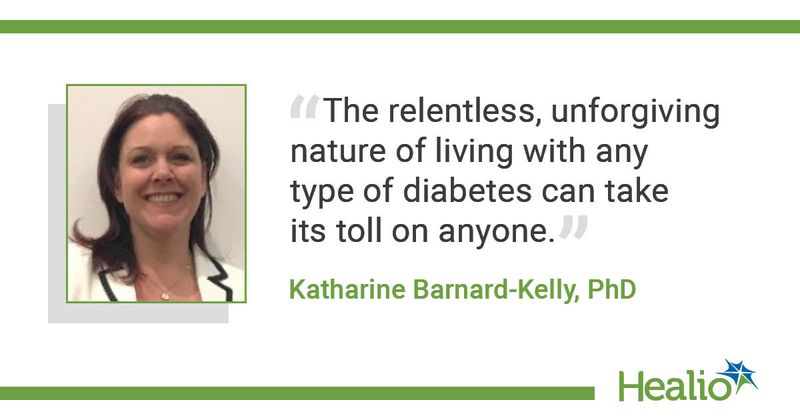Action needed to combat elevated risk for depression, suicide in diabetes
NEW ORLEANS — Risks for depression and suicidal ideation are higher among people with vs. without diabetes, and cases of suicide are likely underreported, according to a presenter at the American Diabetes Association Scientific Sessions.
Katharine Barnard-Kelly, PhD, chief science officer at Spotlight Consultations in Portsmouth, U.K., professor at the Southern Health NHS Foundation Trust and chair of the governing committee of the FDA Reducing Suicide Rates Among Individuals with Diabetes (RESCUE) Collaborative Community, said depression, suicidal ideation and self-harm are more common among people with diabetes than many people realize, affecting both men and women as well as all age groups. The risk is increased even for people using diabetes devices and those achieving optimal glycemic control.

“The relentless, unforgiving nature of living with any type of diabetes can take its toll on anyone,” Barnard-Kelly told Healio.
Risks for suicide, depression higher with diabetes
Barnard-Kelly said rates of suicide and intended self-injury are underestimated among people with diabetes. According to WHO, suicide attempts are at least 20-fold higher than the number of recorded suicide deaths among people with diabetes. Suicide accounts for as many as 7% of recorded deaths in this group, but this is likely underreported, according to Barnard-Kelly, due to difficulties with identifying suicide as the cause of death. In data from one study of 160 cases of insulin overdose, 90% were considered suicidal or parasuicidal, whereas 5% were determined to be accidental. Poor coding and reporting may also contribute to an underestimation of the suicide rate.
“The thing that is unique to diabetes is people have access to insulin, which is a life-preserving hormone,” Barnard-Kelly said during the presentation. “But it’s also very easy access to a very powerful method of taking one’s own life.”
Barnard-Kelly noted suicidal ideation is reported by 15% of people with type 1 diabetes compared with about 9.4% of those in the general population. People with diabetes are three to four times more likely to attempt suicide and two to three times more likely to have depression. The risk for suicide, suicidal ideation and self-harm is even higher for those with diabetes and a comorbid mood disorder. Among adolescents and young adults, those with type 1 diabetes are 61% more likely to report suicidal thoughts compared with those without diabetes. Barnard-Kelly said the increased risk for depression, self-injury and suicide is observed in all subgroups of people with diabetes.
“This affects people of all genders, ages and therapies, including among people using very latest diabetes technologies,” Barnard-Kelly said. “Optimal glycemic control is often believed to equate to a good quality of life, but this simply is not true for many people.”
Diabetes technology and mental health
Struggles with diabetes self-management can lead to depression through questions of self-worth, strength of relationships, fear for the future and more. The emotional and psychological burden of diabetes still increase the risk for depression, self-injury and suicidal thoughts, even with recent advances in management, according to Barnard-Kelly.
“There have been huge advances in diabetes technology with improved glycemic control, quality of life and improved psychosocial functioning,” Barnard-Kelly said during the presentation. “The challenge is that the mental burden of some of these systems remains underappreciated.”
Barnard-Kelly said diabetes devices are not the cause of the mental health burden but have instead allowed providers to identify the depth of the issue more clearly. She noted devices may offer easier methods for injurious behaviors by simplifying the process of insulin administration and misuse. Additionally, Barnard-Kelly said health care professionals underestimate the prevalence of suicidal risk in people with diabetes and feel they lack the resources to address the issue.
“The rapidly increasing prevalence of diabetes devices used by people with type 1 diabetes and the widespread lack of understanding of the mental burden associated with such devices provides a compelling argument for how to have a dialogue for how we onboard these devices for people,” Barnard-Kelly said.
The concerns about depression and suicide in people with diabetes has led to the formation of the FDA RESCUE Collaborative Community. The organization’s mission is to collaborate with stakeholders across health care to improve identification of intended self-injury and suicidal acts by people with diabetes and provide supportive intervention for those at risk.
“I don’t believe depression, suicidal ideation and self-harm in adults with diabetes gets enough attention from providers,” Barnard-Kelly told Healio. “It can be a very challenging issue to raise. That was a contributing factor to the establishment of the FDA RESCUE Collaborative Community. Our goals are to raise awareness; improve identification; provide education to health care providers, people with diabetes and other key stakeholder groups; develop interventions and reduce the rates of suicide and self-injury among people with diabetes.”

